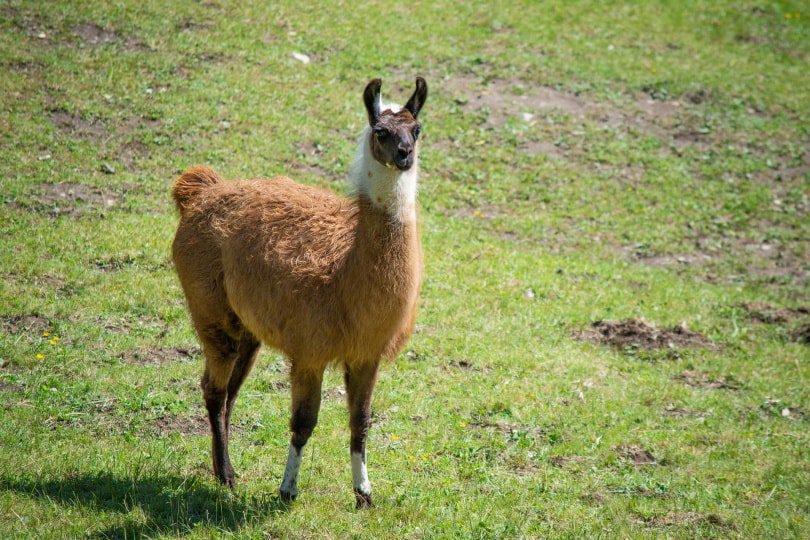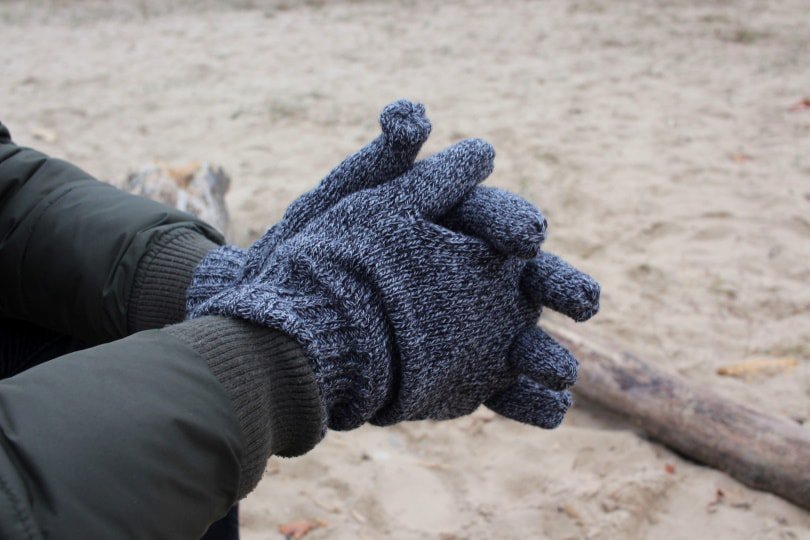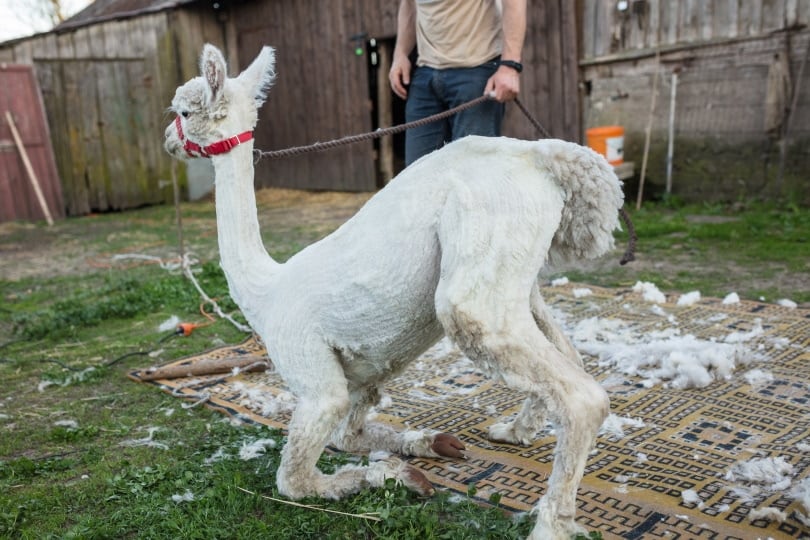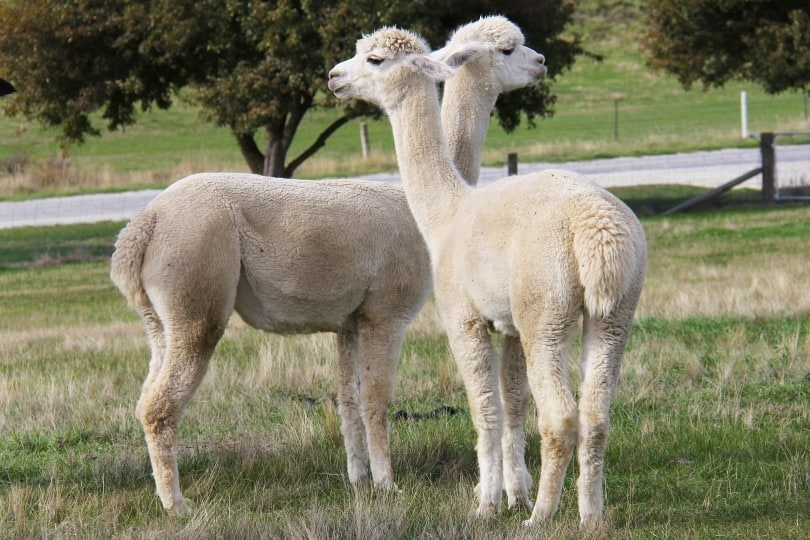New llama owners know that they’ll have to shear their llamas, but many don’t know how to do it. If your llama has less than 2 inches of fleece in the spring or summer, it probably doesn’t need shearing. However, if the fleece is 4 inches long or more, it needs to be shorn.
The good news is that it’s not difficult to shear a llama once you know what to do and get the hang of things. We’ll go through the simple steps involved with shearing a llama. But first, we’ll cover the necessary pre-shearing preparation you should do before you grab those shears and get to work!

Preparation
Clean the Fleece First
It’s much easier to shear a clean llama than a dirty one so be sure to clean the animal before shearing the fleece. If your llama is dirty bathe the animal using a mild shampoo and lukewarm water. Be sure to rinse the animal well and allow the fleece to dry, preferably out in the sun.
It’s best to wash the animal the day before you plan on shearing it so the fleece is completely dry and clean. Of course, be sure to clean the llama’s enclosure well by replacing any dirty and soiled bedding straw so you don’t have to wash the animal again before shearing.
You should know that llamas have a fine undercoat that’s typically used for handicrafts and clothing. The outer “guard hair” is more coarse and it’s often used in rug-making, for wall hangings, and lead ropes. A llama’s fiber can be many different colors ranging from white to gray to red, brown, and black.

Pick up the Necessary Equipment and Brush the Llama
Some people use electric clippers on llamas but traditional sheep shearing scissors work best and especially for beginners. Buy the best shearers you can find to make easy work of the chore and be sure they’re very sharp!
Once the llama is clean and dry and you have your shears, brush the llama’s fleece to remove enough excess hair to keep the animal comfortable. Brushing will also separate the coarse fibers from the finer fibers which is important because the fine fiber is the best quality fleece.
It’s best to use a boar bristle brush that will remove any debris left in the fleece without pulling or irritating your llama. Once the brushing is done, use a hairdryer to blow out stuck layers of fiber. Direct the blower on the surface of the fleece in the direction the fibers grow and keep blowing until it’s visibly clean.
If you’re wondering how a llama will tolerate a hairdryer, you should know that these animals typically find it pleasing to experience a good blowout so don’t worry!


The 4 Steps to Shear a Llama
Now that you know a little about llama fleece and have your equipment ready, it’s time to get to work with those shears. Before you begin, you should know that it’s best to leave about 2 inches of fiber on the llama so its skin is protected properly from the sun. Follow the steps below to ensure the shearing goes along without a hitch.
1. Secure the Llama
It’s not always easy to catch a llama because once you reach for it, it’s gone. Use whatever method works best for you to be able to get your arm around the animal’s neck to make it submit.
Once you’ve captured the llama, you should restrain it while it’s being sheared to avoid accidental slips with the shears. Use a harness and a rope to comfortably secure the llama to a pole or fence so the animal must stay put.
Obviously, the shearing will be easier if the animal stands completely still. But llamas don’t always cooperate so it’s best to have some help. Ask a couple of friends to come and lend a helping hand. Simply have your friends hold the llama still by using the lead rope and some good old-fashioned muscle power!
2. Wear Tight-Fitting Gloves
Now it’s time for you to put on a pair of tight-fitting gloves so you don’t get any blisters from the shears. You can certainly skip this step if you’d like but be prepared to get blisters because it will likely happen.
It is going to take some time with those shears of yours to get the entire llama trimmed. This means your hands will likely get sweaty, raising the risk of developing painful blisters so play it smart and wear gloves!

3. Start Cutting
Lay the blades of the shears lengthwise against the animal’s body while you cut along the spine, starting at the tail, and snipping upward toward the neck. This method will open a “rug” of matted fleece so you can work down either side of the body. Continue making horizontal cuts in the same manner while trying to maintain an intact sheet of fleece as you slice it away from the animal’s body.
Once you’ve worked your way down near a leg, separate the fleece from the body and trim upward to make your job look as smooth as possible. Do the same on the other side then shear off the fleece on the animal’s legs, neck, and tail so the whole job looks balanced.
4. Assess your Work
Don’t expect to do a perfect job of shearing a llama on your first attempt because it takes practice to get it right. The most important thing is to remove the excess fleece while leaving a couple of inches of fiber behind.
Once you’ve sheared the entire body, legs, tail, and neck, stand back, and assess your work. If you see areas you’ve missed, go back, and fix what isn’t up to par.


Conclusion
When you own a llama, the animal must be sheared during the spring to keep its thick coat in check. While you can certainly pay a vet or a groomer to shear your llama, it’s a job you can tackle yourself.
Just follow the steps above and take your time. And don’t be too hard on yourself if you mess up! The most important thing is to remove all but a couple of inches of fleece so your llama looks nice and is more comfortable during the warm weather.
Featured Image Credit: Piqsels
